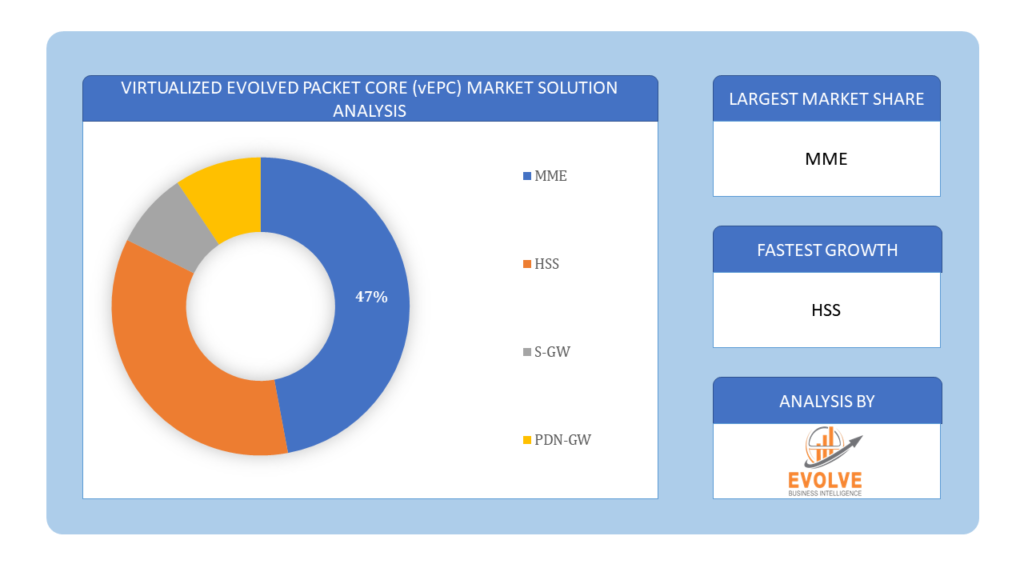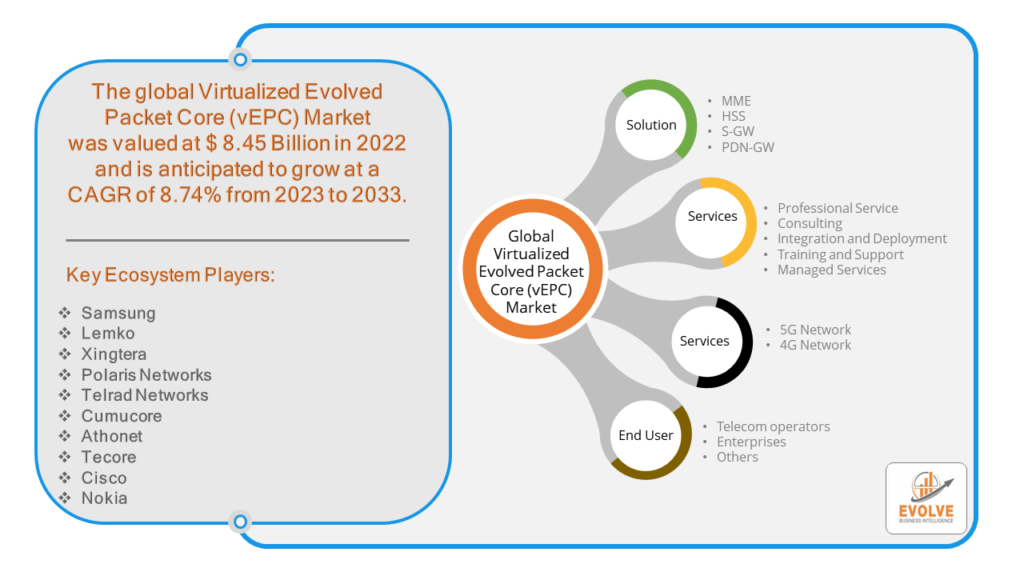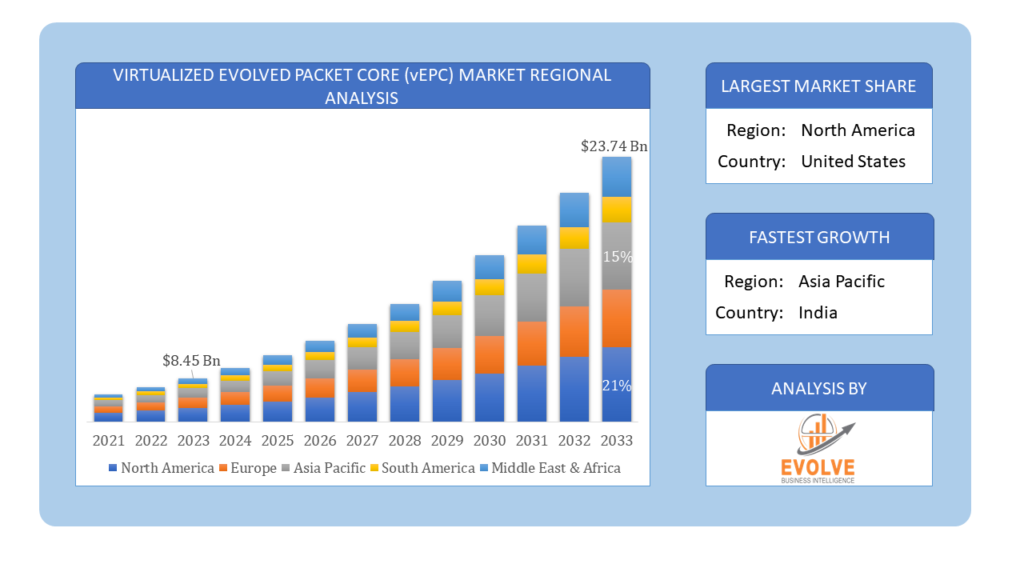Virtualized Evolved Packet Core (vEPC) Market Overview
The Virtualized Evolved Packet Core (vEPC) Market Size is expected to reach USD 23.74 Billion by 2033. The Virtualized Evolved Packet Core (vEPC) Market industry size accounted for USD 8.45 Billion in 2023 and is expected to expand at a compound annual growth rate (CAGR) of 8.74% from 2023 to 2033. The Virtualized Evolved Packet Core (vEPC) market refers to the segment of the telecommunications industry that deals with the deployment and management of virtualized EPC solutions. The EPC is a framework for providing voice and data on a 4G Long-Term Evolution (LTE) network. Virtualized EPC, or vEPC, uses Network Functions Virtualization (NFV) technology to virtualize the core network functions, allowing them to run on standard hardware instead of specialized, proprietary equipment.
The vEPC market represents a growing segment within the mobile network infrastructure landscape, driven by the need for flexible, scalable, and cost-effective solutions for managing data and voice traffic in the era of 4G and 5G.
Global Virtualized Evolved Packet Core (vEPC) Market Synopsis
The COVID-19 pandemic had a significant impact on the Virtualized Evolved Packet Core (vEPC) market. With lockdowns and remote work becoming the norm, there was a substantial increase in data traffic. This surge required telecom operators to enhance their network capacity and reliability, driving the adoption of vEPC solutions which offer scalability and flexibility. The pandemic accelerated the digital transformation in many sectors, including telecommunications. Operators sought to quickly adapt to changing demands, and NFV, including vEPC, provided the agility needed for rapid deployment and scaling. The pandemic underscored the need for advanced technologies and faster internet speeds, leading to an expedited rollout of 5G networks. vEPC is a critical component in 5G architecture, supporting higher efficiency and performance. The pandemic caused disruptions in the global supply chain, affecting the availability of hardware required for network upgrades and expansions. This challenged operators in deploying new infrastructure but also emphasized the need for virtualized solutions that are less dependent on specialized hardware.
Virtualized Evolved Packet Core (vEPC) Market Dynamics
The major factors that have impacted the growth of Virtualized Evolved Packet Core (vEPC) Market are as follows:
Drivers:
Ø Growing Demand for High-Speed Data
The proliferation of smartphones, tablets, and other connected devices has led to a significant increase in data consumption. Consumers and businesses alike demand high-speed, reliable internet connectivity. The rise of streaming services, cloud computing, and other data-intensive applications drives the need for more robust and scalable network solutions. The global rollout of 5G networks necessitates the adoption of more advanced core network solutions like vEPC. 5G networks require higher efficiency, lower latency, and greater capacity, which vEPC can provide. The growing number of IoT devices requires efficient handling of massive amounts of data and device connections. vEPC can efficiently manage the data traffic and signaling from numerous IoT devices.
Restraint:
- Perception of High Initial Investment
Despite the long-term cost benefits, the initial investment in virtualized infrastructure, software licenses, and skilled personnel can be significant. Telecom operators might be concerned about the ROI timeline, especially if the benefits of vEPC deployment take longer to realize. Ensuring that virtualized core network functions deliver the same level of performance and reliability as their hardware-based counterparts can be challenging. There is a shortage of professionals with the necessary skills and expertise to design, deploy, and manage virtualized network solutions. This skills gap can slow down vEPC adoption. Operators need to invest in training and development programs for their staff, which can be resource-intensive.
Opportunity:
⮚ Growth in IoT Applications
The proliferation of IoT devices necessitates a core network capable of handling vast amounts of data and connections efficiently. vEPC offers the scalability to support the exponential growth in IoT devices. Industries such as healthcare, manufacturing, and agriculture are increasingly adopting IoT, driving the demand for reliable and flexible core network solutions like vEPC. vEPC solutions reduce the need for expensive, proprietary hardware, leading to significant cost savings in network infrastructure investments. vEPC solutions often come with advanced security features that can be more easily updated and managed than traditional hardware-based solutions. The flexibility of vEPC allows for more adaptive and responsive security measures to counter emerging threats.
Virtualized Evolved Packet Core (vEPC) Market Segment Overview
By Solution
 Based on Solution, the market is segmented based on MME, HSS, S-GW and PDN-GW. The MME segment dominant the market. The Growing mobile traffic due to more users and devices increases the demand for efficient mobility management. MME’s role in seamless handovers and mobility management is crucial for the transition from 4G to 5G networks. Manages the establishment, maintenance, and release of connections to the UE (User Equipment). Coordinates with HSS for authentication and authorization.
Based on Solution, the market is segmented based on MME, HSS, S-GW and PDN-GW. The MME segment dominant the market. The Growing mobile traffic due to more users and devices increases the demand for efficient mobility management. MME’s role in seamless handovers and mobility management is crucial for the transition from 4G to 5G networks. Manages the establishment, maintenance, and release of connections to the UE (User Equipment). Coordinates with HSS for authentication and authorization.
By Services
Based on End Users, the market segment has been divided into the Professional Service, Consulting, Integration and Deployment, Training and Support and Managed Services. The Managed Services segment dominant the market. The growth can be attributed to the increasing adoption of managed services by businesses seeking to optimize their network infrastructure and streamline their operations. Managed services offer several benefits, including cost savings, enhanced network performance, and access to specialized expertise. By outsourcing the management of their vEPC solutions to experienced service providers, organizations can focus on their core competencies while ensuring the smooth operation and maintenance of their network infrastructure
By Network
Based on Network, the market segment has been divided into the 5G Network and 4G Network. 5G is expected to be fastest growing network. Due to the ballooning demand for high speed data services and rising emphasis on the adoption of advanced technologies such as cloud computing and IoT across industries.
By End User
Based on End User, the market segment has been divided into the Telecom operators, Enterprises and Others. The telecom operators segment dominant the market. The telecom operators have generated the maximum market revenue. Telecom operators in many countries have already started using virtualized evolved packet core solutions. The South Korean carrier SK Telecom has successfully implemented a virtualized evolving packet core system. Telecom companies in North America and Asia-Pacific have also applied the technology to boost network effectiveness.
Global Virtualized Evolved Packet Core (vEPC) Market Regional Analysis
Based on region, the global Virtualized Evolved Packet Core (vEPC) Market has been divided into North America, Europe, Asia-Pacific, the Middle East & Africa, and Latin America. North America is projected to dominate the use of the Virtualized Evolved Packet Core (vEPC) Market followed by the Asia-Pacific and Europe regions.
Virtualized Evolved Packet Core (vEPC) North America Market
North America holds a dominant position in the Virtualized Evolved Packet Core (vEPC) Market. North America, particularly the United States and Canada, has a well-developed telecommunications infrastructure, which supports the rapid adoption of vEPC solutions. The aggressive rollout of 5G networks by major telecom operators like Verizon, AT&T, and T-Mobile drives significant demand for vEPC. North America is a leader in adopting cutting-edge technologies such as NFV, SDN, and IoT, creating a favorable environment for vEPC growth.
Virtualized Evolved Packet Core (vEPC) Asia-Pacific Market
The Asia-Pacific region has indeed emerged as the fastest-growing market for the Virtualized Evolved Packet Core (vEPC) Market industry. The Asia-Pacific region, particularly China, Japan, South Korea, and India, is experiencing rapid growth in mobile internet usage, necessitating robust core network solutions. Countries like China and South Korea are at the forefront of 5G deployment, driving substantial demand for vEPC to support their advanced network needs. The region’s economic growth supports substantial investments in telecom infrastructure, including vEPC.
Competitive Landscape
The global Virtualized Evolved Packet Core (vEPC) Market is highly competitive, with numerous players offering a wide range of software solutions. The competitive landscape is characterized by the presence of established companies, as well as emerging startups and niche players. To increase their market position and attract a wide consumer base, the businesses are employing various strategies, such as product launches, and strategic alliances.
Prominent Players:
- Samsung
- Lemko
- Xingtera
- Polaris Networks
- Telrad Networks
- Cumucore
- Athonet
- Tecore
- Cisco
- Nokia
Scope of the Report
Global Virtualized Evolved Packet Core (vEPC) Market, by Solution
- MME
- HSS
- S-GW
- PDN-GW
Global Virtualized Evolved Packet Core (vEPC) Market, by Services
- Professional Service
- Consulting
- Integration and Deployment
- Training and Support
- Managed Services
Global Virtualized Evolved Packet Core (vEPC) Market, by Network
- 5G Network
- 4G Network
Global Virtualized Evolved Packet Core (vEPC) Market, by End User
- Telecom operators
- Enterprises
- Others
Global Virtualized Evolved Packet Core (vEPC) Market, by Region
- North America
- US
- Canada
- Mexico
- Europe
- UK
- Germany
- France
- Italy
- Spain
- Benelux
- Nordic
- Rest of Europe
- Asia Pacific
- China
- Japan
- South Korea
- Indonesia
- Austalia
- Malaysia
- India
- Rest of Asia Pacific
- South America
- Brazil
- Argentina
- Rest of South America
- Middle East & Africa
- Saudi Arabia
- UAE
- Egypt
- South Africa
- Rest of Middle East & Africa
| Parameters | Indicators |
|---|---|
| Market Size | 2033: $23.74 Billion/strong> |
| CAGR | 8.74% CAGR (2023-2033) |
| Base year | 2022 |
| Forecast Period | 2023-2033 |
| Historical Data | 2021 |
| Report Coverage | Revenue Forecast, Competitive Landscape, Growth Factors, and Trends |
| Key Segmentations | Solution, Services, Network, End User |
| Geographies Covered | North America, Europe, Asia-Pacific, Latin America, Middle East, Africa |
| Key Vendors | Samsung, Lemko, Xingtera, Polaris Networks, Telrad Networks, Cumucore, Athonet, Tecore, Cisco and Nokia |
| Key Market Opportunities | • Growth in IoT Applications • Cost Reduction and Operational Efficiency |
| Key Market Drivers | • Growing Demand for High-Speed Data • Increased Adoption of IoT Devices |
REPORT CONTENT BRIEF:
- High-level analysis of the current and future Virtualized Evolved Packet Core (vEPC) Market trends and opportunities
- Detailed analysis of current market drivers, restraining factors, and opportunities in the future
- Virtualized Evolved Packet Core (vEPC) Market historical market size for the year 2021, and forecast from 2023 to 2033
- Virtualized Evolved Packet Core (vEPC) Market share analysis at each product level
- Competitor analysis with detailed insight into its product segment, Government & Defense strength, and strategies adopted.
- Identifies key strategies adopted including product launches and developments, mergers and acquisitions, joint ventures, collaborations, and partnerships as well as funding taken and investment done, among others.
- To identify and understand the various factors involved in the global Virtualized Evolved Packet Core (vEPC) Market affected by the pandemic
- To provide a detailed insight into the major companies operating in the market. The profiling will include the Government & Defense health of the company’s past 2-3 years with segmental and regional revenue breakup, product offering, recent developments, SWOT analysis, and key strategies.








